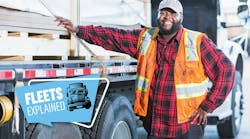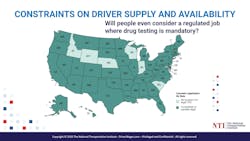Key takeaways:
- Private fleets should focus on creating clear career paths for entry-level employees to encourage retention and skill growth.
- Expanding efforts to attract younger workers and women can help fill challenging positions and improve workforce diversity.
- Addressing the diverse needs and expectations of different generations in the workplace is essential for promoting a cohesive work environment.
One of the best ways to supply your fleet with stellar drivers—and office workers—who want to stick with your company for the long haul is to grow your own.
Accident-free million-mile drivers get started somewhere. And so do future executives. For private fleets, which run transportation operations for companies focused on retail, construction, foodservice, and more, opportunities abound, according to Leah Shaver, National Transportation Institute president and CEO.
Shaver visited with private fleet executives during the National Private Truck Council’s annual conference in Orlando last week. Along with delivering this year’s keynote address, she and James Jaillet, NTI’s chief intelligence officer, presented an educational workshop for fleet leaders.
In her keynote address, Shaver emphasized the importance of fleets in growing their internal workforce by helping entry-level employees find more purpose and see themselves growing with the organization.
“Can you believe the pay for a yard driver has increased 16% in four years?” Shaver said during her address to hundreds of private fleet executives on Sunday, May 11, at the Orange County Convention Center. “This is an entry-level job where you can groom and grow your own drivers into other, more needed jobs in the fleet.”
Those future jobs for entry-level yard jockeys could be the harder-to-fill-and-retain long-haul driving or important regional delivery jobs.
Shaver advised fleet leaders to build up their labor supply chains by attracting more young people, recruiting women, and creating job advancement opportunities. While many private fleets have relied for years on enticing experienced for-hire drivers with more pay, Shaver said that private fleets also have opportunities to develop their drivers from plucking people out of their warehouses or other entry-level positions to put them on a growing career path.
After the keynote address and Shaver’s workshop in Orlando, she sat down with FleetOwner to discuss how successful private fleets are growing their workforces on the road and in the back office.
Here is an edited Q&A of the discussion:
FO: What are some of the pain points that private fleet leaders are bringing up to you during the conference?
One challenge was having a training program from the ground up. Some call it “dock to driver.” We call it career pathing, which is creating and articulating career paths so folks want to join the company and understand what’s great about the company that would make them want to stay.
There were some questions about whether some of the entry-level jobs in the industry can also offer the aspect of being home more. Flexibility in pay has increased so significantly in the last few years. One of the jobs, for example, we had in our deck was that spotter driver pay has gone up 16% in recent years. If that’s true, that could be a rewarding career choice that gets you home every night. But if that driver continued on a career path to the next level, they could make more but be away from home more.
FO: Do you have examples of fleets that can build better internal career paths for entry-level employees and drivers?
You should incentivize the next level with pay, programs, and upskilling.
One great example is that several private fleets we work with have different segments of drivers doing different areas of work. They have different areas of specialty.
We could take a driver with no endorsements and a certain skill level, and then upskill them into doing much more rewarding jobs from a pay perspective. Also, work with that driver to build their skills, helping them get a hazmat endorsement to haul fuel or a job with more delivery stops and customer-facing work. Those jobs can be rewarding.
FO: How is state-level cannabis reform changing trucking’s potential worker pool?
THC access is legal in all but a few states. We now operate in a society where more Americans have access to THC before they turn 21—and probably earlier. They are not considering a job in a regulated industry.
If hair testing becomes part of the FMCSA regulations, that would also impact potential new entrants.
FO: You’re a young Gen Xer, caught in the middle of two big generations of workers. What is the biggest challenge among the various generations at work?
Communication and flexibility. There are four generations of drivers and people working today. In general, they all have different job expectations and needs.
One fleet told me they have boomers and millennials in the office. The millennials are of childbearing age and need accommodations to tackle their careers, meet milestones, and keep family commitments. Those commitments can keep them from doing their jobs in the office—for example, working a second shift or on Saturdays. The older people in the workforce have a gap in understanding why you would even make accommodations to help that millennial worker grow.
Just because remote work options didn’t exist when older workers were young, doesn’t mean that today’s next generation shouldn’t benefit.
Understanding and bridging the generational gaps is a big challenge in the workforce. Especially for young people because they might be trained by a boomer who doesn’t know how to level with them, communicate, amplify their strengths, and focus on how that person can grow within the organization.
FO: What are some successful ways fleets set up different workers for better career paths?
Let’s discuss women and their unique needs at different ages and roles.
Regarding truck driving, women enter the industry at an older average age (in their 50s) than men because they generally wait for their children to grow up.
Conversely, those in the office tend to get trampled and stuck into midlevel roles because there isn’t enough flexibility to be a mother and a worker.
Companies listening to feedback and understanding those special needs are making accommodations. They’re doing really well at recruiting younger women and career pathing them into jobs and other opportunities.
On the driver side, young people like technology and embrace it. Young people like safety and embrace it. Young people really want to understand what their next step is. Companies that hold on to them communicate better. They regularly remind them what their next step is in their career, how they can upskill a little bit more, and how they can increase their exposure and awareness.
Along those lines, some really standout companies offer dock-to-driver programs that are career paths for various jobs.
About the Author
Josh Fisher
Editor-in-Chief
Editor-in-Chief Josh Fisher has been with FleetOwner since 2017. He covers everything from modern fleet management to operational efficiency, artificial intelligence, autonomous trucking, alternative fuels and powertrains, regulations, and emerging transportation technology. Based in Maryland, he writes the Lane Shift Ahead column about the changing North American transportation landscape.







